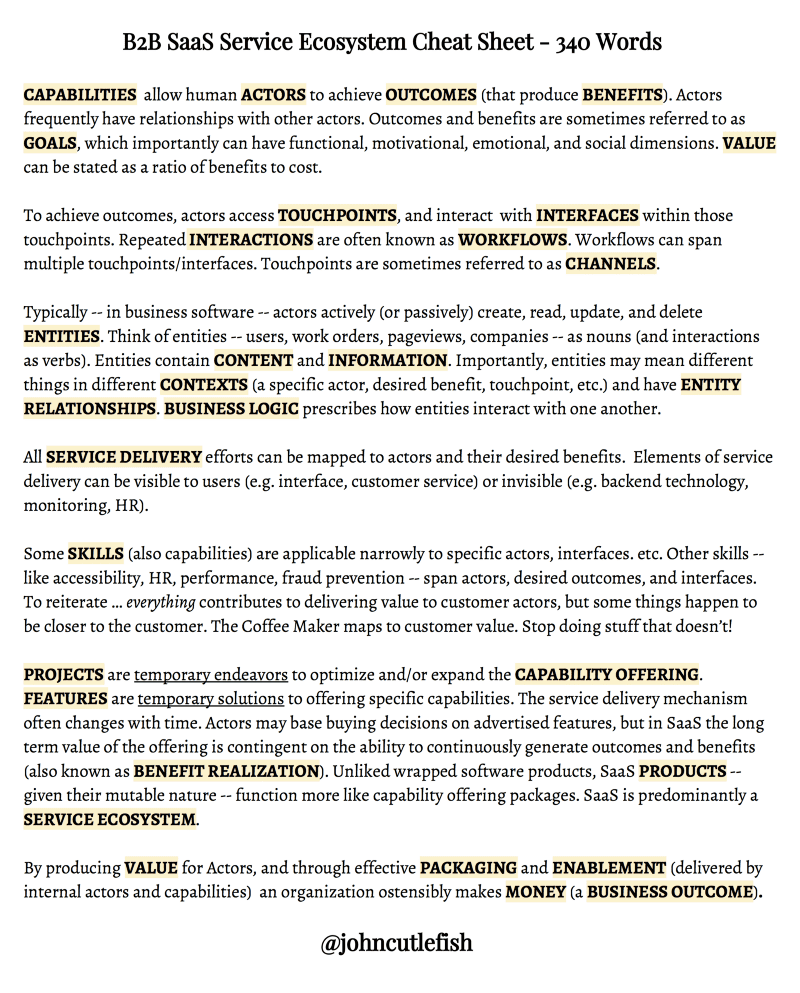To facilitate some training, I wrote up this quick cheat sheet of terms used in service ecosystems (where B2B SaaS products play). I have a PDF of this here . Feel free to share, but please keep the attribution (to me) on the doc. That way I’ll be liable for the spelling mistakes, not you.
Note: I wish I had time to make a fancy infographic or animated movie thing. Maybe later.
CAPABILITIES allow human ACTORS to achieve OUTCOMES (that produce BENEFITS). Actors frequently have relationships with other actors. Outcomes and benefits are sometimes referred to as GOALS, which importantly can have functional, motivational, emotional, and social dimensions. VALUE can be stated as a ratio of benefits to cost.
To achieve outcomes, actors access TOUCHPOINTS, and interact** with INTERFACES within those touchpoints. Repeated INTERACTIONS are often known as WORKFLOWS. Workflows can span multiple touchpoints/interfaces. Touchpoints are sometimes referred to as CHANNELS**.
Typically — in business software — actors actively (or passively) create, read, update, and delete ENTITIES. Think of entities — users, work orders, pageviews, companies — as nouns (and interactions as verbs). Entities contain CONTENT and INFORMATION. Importantly, entities may mean different things in different CONTEXTS (a specific actor, desired benefit, touchpoint, etc.) and have ENTITY RELATIONSHIPS. BUSINESS LOGIC prescribes how entities interact with one another.
All SERVICE DELIVERY efforts can be mapped to actors and their desired benefits. Elements of service delivery can be visible to users (e.g. interface, customer service) or invisible (e.g. backend technology, monitoring, HR).
Some SKILLS (also capabilities)* **are applicable narrowly to specific actors, interfaces. etc. Other skills — like accessibility, HR, performance, fraud prevention — span actors, desired outcomes, and interfaces. To reiterate … everything *contributes to delivering value to customer actors, but some things happen to be closer to the customer. The Coffee Maker maps to customer value. Stop doing stuff that doesn’t!
PROJECTS are temporary endeavors to optimize and/or expand the CAPABILITY OFFERING. FEATURES are temporary solutions to offering specific capabilities. The service delivery mechanism often changes with time. Actors may base buying decisions on advertised features, but in SaaS the long term value of the offering is contingent on the ability to continuously generate outcomes and benefits (also known as BENEFIT REALIZATION). Unlike wrapped software products, SaaS PRODUCTS — given their mutable nature — function more like capability offering packages. SaaS is predominantly a SERVICE ECOSYSTEM.
By producing VALUE for Actors, and through effective PACKAGING and ENABLEMENT (delivered by internal actors and capabilities) an organization ostensibly makes MONEY (a BUSINESS OUTCOME).
